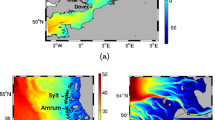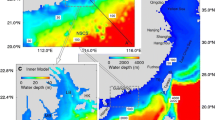Abstract
A terrain-following ocean general circulation model is implemented for simulating tidal and residual circulation patterns in the Hooghly Estuary and its adjacent coastal oceans (HECO) on the east coast of India. The model is forced with time-varying tidal levels and momentum fluxes at the eastern and southern open boundaries, and winds at the air–sea interface. Simulated tidal levels and currents are compared well with the observations. Based on model solutions, spatial patterns of semi-diurnal and diurnal tides and circulation are described. The residual circulation shows prevalence of ocean-ward along channel flow from north to south with distinct differential circulation patterns on its right and left flanks of the outer estuary. A mesoscale eddy associated with residual circulation has been occurring in the southwestern flank of the HECO, adjacent to the Digha coast. This is associated with enriched chlorophyll_a concentration (Chla), causing the region as the suitable place for the fishing activity. The residual currents in the left of the channel (toward the Sunderban) in the southeastern flank of the HECO are eastward and diverging in nature and are associated with reduced Chla.









Similar content being viewed by others
References
Biswas, H., Mukhopadhyay, S. K., De, T. K., Sen, S., & Jana, T. K. (2004). Biogenic controls on the air-water carbon dioxide exchange in the Sundarban mangrove environment, northeast coast of Bay of Bengal, India. Limnology and Oceanography, 49, 95–101.
Blumberg, A. F., & Mellor, G. L. (1987). A description of a three-dimensional coastal ocean circulation model. In N. S. Heaps (Ed.), Three dimensional coastal ocean models (pp. 1–16). Washington, DC: American Geophysical Union.
Carton, J. A., Giese, B. S., & Grodsky, S. A. (2005). Sea level rise and the warming of the oceans in the Simple Ocean Data Assimilation (SODA) ocean reanalysis. Journal Geophysical Research, 110, C09006. https://doi.org/10.1029/2004JC002817.
Chatterjee, A. K. (1978). Two dimensional mathematical model of a tidal estuary. Proc. 47th Research session of CBIP, Hubli Dharwar, India.
Chatterjee, A. K. (1983). Two dimensional non linear vertically integrated model of a tidal estuary. River Behaviour and Control, 15, 1–11.
Denniss, T., & Middleton, J. H. (1994). Effects of viscosity and bottom friction on recirculating flows. Journal of the Geophysical Research, 99, 10183–10192.
Foreman, M. G. G. (1978). Manual for tidal currents analysis and prediction. Pacific Marine Science Report 78-6, Institute of Ocean Sciences, Particia Bay, Victoria, B.C.
Gole, C. V., & Vaidyaraman, P. P. (1969). Salinity distribution and effect of fresh water flows in the Hoogly estuary. Journal of Coastal Engineering, 10, 1412–1422.
Holloway, J., Rehllsch, M. M., Clark, N. A., Balmer, D. E., Austin, G., Yates, M. G., Clarke, R. T., Swetnam, R. D., Eastwood, J. A., Duren, S. E. A. le V. dit, GossCustard, J. D., & West, J. R. (1996). Estuary, sediments and shorebirds II. Shorebird usage of intertidal areas. (BTO Research Report no 156) Thetford: British Trust for Ornithology.
Lefèvre, F., Lyard, F., Le Provost, C., & Schrama, E. J. O. (2002). FES99: A tide finite element solution assimilating tide gauge and altimetric information. Journal of Atmospheric and Oceanic Technology, 19(9), 1345–1356.
Levitus, S. (1982). Climatological atlas of the world ocean. Washington D.C: U.S. Government Printing Office. NOAA Professional Paper 13.
Mc Dowell, D. M., & Prandle, D. (1972). Mathematical model for river Hooghly. Journal of Waterways and Harbour Division ASCE, 98, 225–242.
Mellor, G. L., & Yamada, T. (1982). Development of a turbulence closure model for geophysical fluid problems. Review of Geophysics and Space Physics, 20, 851–875.
Nayak, R. K., Salim, M., Mitra, D., Sridhar, P. N., Mohanty, P. C., & Dadhwal, V. K. (2014). Tidal and residual circulation in the Gulf of Khambhat and its surrounding on the west coast of India. Journal of the Indian Society of Remote Sensing, 43, 151–162. https://doi.org/10.1007/s12524-014-0387-3.
Nayak, R. K., Salim, M., Sasamal, S. K., Mohanthy, P. C., Bharadwaj, R. K., Rao, K. H., et al. (2016). Assessment of SARAL-ALTIKA tidal corrections in the coastal oceans around India. Marine Geodesy, 39(5), 331–347.
Nayak, R. K., & Shetye, S. R. (2003). Tides in the Gulf of Khambhat, west coast of India. Estuarine Coastal Shelf Science, 57, 249–254.
Padhy, P. C., Nayak, R. K., Dadhwal, V. K., Salim, M., Mitra, D., Chaudhury, S. B., et al. (2016). Estimation of partial pressure of carbon dioxide and air–sea fluxes in Hooghly estuary based on in situ and satellite observations. Journal of the Indian Society of Remote Sensing, 44(1), 135–143.
Robertson, R. (2001). Internal tides and baroclinicity in the southern Weddell Sea: Part I: Model description, and comparison of model results to observations. Journal of the Geophysical Research, 106, 27001–27016.
Sadhuram, Y., Sharma, V. V., Ramanamurthy, T. V., & Rao, B. P. (2005). Seasonal variability of physic-chemical characteristics of the Haldia channel of Hooghly estuary, India. Journal of Earth System Science, 114(1), 37–49.
Salim, M., Nayak, R. K., Mohanthy, P. C., Sasamal, S. K., Dadhwal, V. K., Dutt, C. B. S., et al. (2015). Characterization of the seasonal circulation patterns and its application on oil spill transport in the northwestern continental shelf of India. Marine Geodesy, 38, 241–260. https://doi.org/10.1080/01490419.2015.1008709.
Sinha, P. C., & Mitra, A. (1988). Tidally induced residual circulation. Journal of Computers & Mathematics with Applications, 16, 153–167. https://doi.org/10.1016/0898-1221(88)90029-6.
Sinha, P. C., Guliani, P., Jena, G. K., Rao, A. D., Dube, S. K., Chatterjee, A. K., et al. (2004). A breadth averaged numerical model for suspended sediment transport in Hooghly estuary, East Coast of India. Natural Hazards, 32, 239–255.
Sinha, P. C., Rao, Y. R., Dube, S. K., & Murty, C. R. (1998). A numerical model for residual circulation and pollutant transport in a tidal estuary (Hooghly) of NE Coast of India. Indian Journal of Marine Sciences, 27, 129–137.
Sinha, P. C., Rao, Y. R., Dube, S. K., Murty, C. R., & Chatterjee, A. K. (1999). Application of two turbulence closure schemes in the modeling of Tidal currents and salinity in the Hooghly estuary. Estuarine and Coastal Shelf Science, 48, 649–663.
Sinha, P. C., Rao, Y. R., Dube, S. K., & Rao, A. D. (1995). Modeling of circulation and salinity on Hooghly estuary. Marine Geodesy, 19, 197–213.
Sinha, P. C., Rao, Y. R., Dube, S. K., & Rao, A. D. (1996). Numerical investigation of tide surge interaction in Hooghly estuary, India. Marine Geodesy, 19, 235–255.
Acknowledgements
This work is carried out as part of coastal ocean analysis system of national remote sensing technology development project. Our sincere thanks to director NRSC for his continuous encouragement and supports. We thank the director of INCOIS for his continuous support and advice. We acknowledge various data sources such as INCOIS for tide gauge information, MODIS for Chlorophyll observation, NHO and GEBCO for bathymetry data sets.
Author information
Authors and Affiliations
Corresponding author
About this article
Cite this article
Mishra, S.K., Nayak, R.K., Mahanty, P.C. et al. Tidal Circulation in the Hooghly Estuary and Adjacent Coastal Oceans. J Indian Soc Remote Sens 47, 705–714 (2019). https://doi.org/10.1007/s12524-018-0927-3
Received:
Accepted:
Published:
Issue Date:
DOI: https://doi.org/10.1007/s12524-018-0927-3




